 The Clone Conspiracy #1 (of 5) — Writer: Dan Slott; Pencils: Jim Cheung; Inks: John Dell; Colors: Justin Ponsor
The Clone Conspiracy #1 (of 5) — Writer: Dan Slott; Pencils: Jim Cheung; Inks: John Dell; Colors: Justin Ponsor
Mosaic #1 — Writer: Geoffrey Thorne; Art: Khary Randolph; Colors: Emilio Lopez
Solo #1 — Writers: Gerry Duggan and Geoffrey Thorne; Art: Paco Diaz; Colors: Israel Silva
The Great Lakes Avengers #1 — Writer: Zac Gorman; Art: Will Robson; Colors: Tamra Bonvillain
Of the Marvel debuts this week, Clone Conspiracy is probably the most-anticipated; the Amazing Spider-Man comic has been building up to it for months now. Basically, Spidey’s old enemy, the Jackal, has perfected a way of  bringing people back from the dead: as long as there’s a couple of skin cells or hair or other DNA, he can grow a new version of the dearly departed, complete with the original’s memories (at least, up to the point when the sample was taken). The Spider-Man books have had a pretty high body count over the years, starting with Uncle Ben in that very first origin story, so, as you might imagine, this leads to a number of familiar faces reappearing; that’s both the fun of this mini-series and the problem, since we all know few, if any, of those new/old characters are going to be sticking around permanently. So far, however, so good: regular spider-writer Dan Slott does his usual good job with everyone, and there’s some emotional kick in seeing the various returns; the art, by Cheung, is straight-ahead superhero stuff that’s decent at handling all those different characters, both good guys and bad, who’ve come back. Mosaic is kind of a “What if Lebron James got super-powers?”: it’s about an MVP-
bringing people back from the dead: as long as there’s a couple of skin cells or hair or other DNA, he can grow a new version of the dearly departed, complete with the original’s memories (at least, up to the point when the sample was taken). The Spider-Man books have had a pretty high body count over the years, starting with Uncle Ben in that very first origin story, so, as you might imagine, this leads to a number of familiar faces reappearing; that’s both the fun of this mini-series and the problem, since we all know few, if any, of those new/old characters are going to be sticking around permanently. So far, however, so good: regular spider-writer Dan Slott does his usual good job with everyone, and there’s some emotional kick in seeing the various returns; the art, by Cheung, is straight-ahead superhero stuff that’s decent at handling all those different characters, both good guys and bad, who’ve come back. Mosaic is kind of a “What if Lebron James got super-powers?”: it’s about an MVP-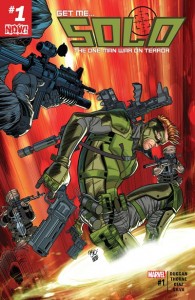 level NBA player who encounters the terrigen mists, turns out to have some Inhuman ancestry, and comes out of the cocoon with the ability to enter other people’s bodies, Deadman-like, and control them; the twist is that he can access all of their memories, too, and if he’s not careful they’re all rattling around in his head (hence the title, since he’s made up of all those bits and pieces of other people he’s possessed). Randolph (Tech Jacket) is just OK at the face and figure work, but brings some imagination to the bigger splash pages that show off Mosaic’s costume, powers and ways of interacting with his partners/victims, and this debut issue should do its job of bringing readers back for a second look. Thorne, the writer here, is also co-writing another Marvel first this week, Solo, about a low-level but high-tech mercenary who gets recruited by S.H.I.E.L.D. for black-ops terrorist-fighting work. The terrorist angle gives it a little ripped-from-the-headlines oomph, and the title
level NBA player who encounters the terrigen mists, turns out to have some Inhuman ancestry, and comes out of the cocoon with the ability to enter other people’s bodies, Deadman-like, and control them; the twist is that he can access all of their memories, too, and if he’s not careful they’re all rattling around in his head (hence the title, since he’s made up of all those bits and pieces of other people he’s possessed). Randolph (Tech Jacket) is just OK at the face and figure work, but brings some imagination to the bigger splash pages that show off Mosaic’s costume, powers and ways of interacting with his partners/victims, and this debut issue should do its job of bringing readers back for a second look. Thorne, the writer here, is also co-writing another Marvel first this week, Solo, about a low-level but high-tech mercenary who gets recruited by S.H.I.E.L.D. for black-ops terrorist-fighting work. The terrorist angle gives it a little ripped-from-the-headlines oomph, and the title  character’s everyman/regular schmo personality makes him easy to like, although otherwise it’s only mildly interesting; readers of the recently-cancelled S.H.I.E.L.D. book, or fans of high-tech espionage thrillers, should like it. That leaves Great Lakes Avengers, a tongue-in-cheek book about life as a group of D-list heroes with sort-of powers; the Robson art is appealing (he reminds me a little of Art Adams), and while it’s mostly-satirical and feather-light, it’s kind of fun too: one of those comics that could develop a cult following, if it manages to hit the right tone and style with readers.
character’s everyman/regular schmo personality makes him easy to like, although otherwise it’s only mildly interesting; readers of the recently-cancelled S.H.I.E.L.D. book, or fans of high-tech espionage thrillers, should like it. That leaves Great Lakes Avengers, a tongue-in-cheek book about life as a group of D-list heroes with sort-of powers; the Robson art is appealing (he reminds me a little of Art Adams), and while it’s mostly-satirical and feather-light, it’s kind of fun too: one of those comics that could develop a cult following, if it manages to hit the right tone and style with readers.
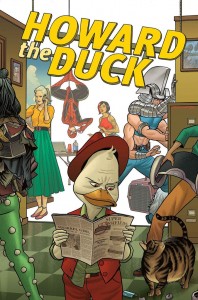 Howard the Duck #11 — Writer: Chip Zdarsky; Pencils: Joe Quinones; Inks: Joe Rivera and Marc Deering with Joe Quinones; Colors: Jordan Gibson with Joe Quinones
Howard the Duck #11 — Writer: Chip Zdarsky; Pencils: Joe Quinones; Inks: Joe Rivera and Marc Deering with Joe Quinones; Colors: Jordan Gibson with Joe Quinones
Moon Knight #7 — Writer: Jeff Lemire; Art/Colors: Francesco Francavilla and James Stokoe;
Old Man Logan #12 — Writer: Jeff Lemire; Art: Andrea Sorrentino; Colors: Marcelo Maiolo
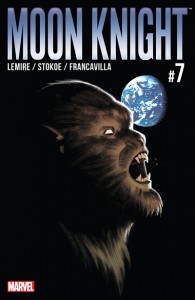 Uncanny Avengers #15 — Writer: Gerry Duggan; Art: Pepe Larraz; Colors: David Curiel
Uncanny Avengers #15 — Writer: Gerry Duggan; Art: Pepe Larraz; Colors: David Curiel
Ulysses #3 (of 3) — Writer: Al Ewing; Layouts: Karl Kesel; Art: Jefte Palo; Colors: Nick Filardi
Punisher #6 — Writer: Becky Cloonan; Art: Steve Dillon; Colors: Frank Martin with Lee Duhig
The other Marvel books (and yes, there were a lot of them this week). Howard the Duck #11 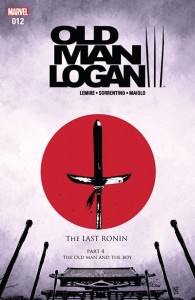 gets all meta for its final issue, as an alien named Chipp turns out to be the writer of Howard’s adventures, and we get a bunch of dangling plot threads wrapped up, plus two pages from Zdarsky in the back where he talks about the fun he’s had on this incarnation of the character, and gets points for name-checking original Howard creator Steve Gerber a couple of times. Moon Knight has been getting reasonably crazy since its relaunch, with its multiple-personality lead involved in an Inception-like set of dreamworlds or
gets all meta for its final issue, as an alien named Chipp turns out to be the writer of Howard’s adventures, and we get a bunch of dangling plot threads wrapped up, plus two pages from Zdarsky in the back where he talks about the fun he’s had on this incarnation of the character, and gets points for name-checking original Howard creator Steve Gerber a couple of times. Moon Knight has been getting reasonably crazy since its relaunch, with its multiple-personality lead involved in an Inception-like set of dreamworlds or  alternate realities, one inside the next; this issue offers Francavilla and Stokoe art on a werewolves-on-the-moon sequence that’s as lurid and gonzo as an underground comic, and then flips back to New York City. Which reality is “real”? Are any of them? No answers yet, but writer Lemire seems to know, and following his twisty plot isn’t at all a bad way to spend your comics-reading time. Old Man Logan, also by Lemire, has Wolverine fighting a boy monk with psi powers whom Logan killed in his own timeline, and who fears the same fate in this one. More twisty time-travel
alternate realities, one inside the next; this issue offers Francavilla and Stokoe art on a werewolves-on-the-moon sequence that’s as lurid and gonzo as an underground comic, and then flips back to New York City. Which reality is “real”? Are any of them? No answers yet, but writer Lemire seems to know, and following his twisty plot isn’t at all a bad way to spend your comics-reading time. Old Man Logan, also by Lemire, has Wolverine fighting a boy monk with psi powers whom Logan killed in his own timeline, and who fears the same fate in this one. More twisty time-travel 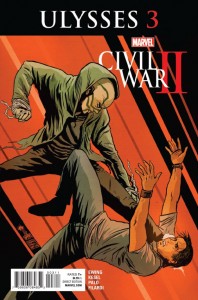 paradoxes from Lemire, with the added attraction of the very well-designed painted art by Sorrentino, enhanced by Maiolo’s glowing, effective coloring. Uncanny Avengers #15 is billed as a “Civil War II aftermath” on the cover (seriously, Marvel didn’t plan for their big event to end up two months late? All of their big events end up late…), although we don’t get any solid information about what’s going to happen, other than that the Hulk’s body is getting stolen by The Hand, who want to reanimate it, and our team has to stop them. Not bad if you like seeing Deadpool in a team book, especially scripted by his current series writer.
paradoxes from Lemire, with the added attraction of the very well-designed painted art by Sorrentino, enhanced by Maiolo’s glowing, effective coloring. Uncanny Avengers #15 is billed as a “Civil War II aftermath” on the cover (seriously, Marvel didn’t plan for their big event to end up two months late? All of their big events end up late…), although we don’t get any solid information about what’s going to happen, other than that the Hulk’s body is getting stolen by The Hand, who want to reanimate it, and our team has to stop them. Not bad if you like seeing Deadpool in a team book, especially scripted by his current series writer.  Ulysses concludes its Civil Wars II spin-off run with the young Inhuman getting schooled by Karnak’s aggressively, and amusingly, violent zen techniques, and growing up a little on the way; it’s particularly worthwhile if you want to know more about both characters, and how their powers work. Finally, Punisher continues to showcase Steve Dillon’s iconic take on the character, with Becky Cloonan proving almost as adept as Garth Ennis at mining the depths of depravity that people will descend to, only to have Frank show up to render judgment and, inevitably, retribution.
Ulysses concludes its Civil Wars II spin-off run with the young Inhuman getting schooled by Karnak’s aggressively, and amusingly, violent zen techniques, and growing up a little on the way; it’s particularly worthwhile if you want to know more about both characters, and how their powers work. Finally, Punisher continues to showcase Steve Dillon’s iconic take on the character, with Becky Cloonan proving almost as adept as Garth Ennis at mining the depths of depravity that people will descend to, only to have Frank show up to render judgment and, inevitably, retribution.
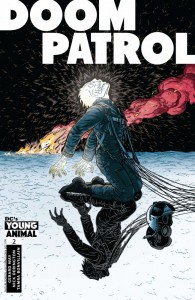 Doom Patrol #2 — Writer: Gerard Way; Art: Nick Derington; Colors: Tamra Bonvillain
Doom Patrol #2 — Writer: Gerard Way; Art: Nick Derington; Colors: Tamra Bonvillain
American Vampire Anthology #2 — Creators: Various
The Lost Boys #1 (of 6) — Writer: Tim Seeley; Art: Scott Godlewski; Colors: Trish Mulvihill
Two sophomore issues and a debut: Doom Patrol is more linear than its whipsaw-like first issue, with Larry “Negative Man” Trainor and Cliff “Robotman” Steele turning up (or, in Cliff’s case, getting reassembled), and appearances by a couple of the more obscure members of Grant Morrison’s 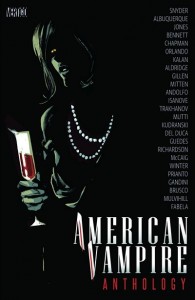 run (Flex Mentallo, for one) indicating that Gerard Way intends to be just as oddly surreal as he was: good news, especially with Derington’s clear, deadpan art making even the most hallucinatory scenes seem grounded and believable. American Vampire Anthology is just that, over 70 pages of art spread across ten short stories about the title characters for $7.99, with Scott Snyder providing a framing sequence/intro story and work by Rafael Albuquerque, Joelle Jones, Christopher Mitten, Marguerite Bennett, Richard Isanove, Andrea Mutti, Szymon Kudranski, Kieron Gillen and Renaldo Guedes, among
run (Flex Mentallo, for one) indicating that Gerard Way intends to be just as oddly surreal as he was: good news, especially with Derington’s clear, deadpan art making even the most hallucinatory scenes seem grounded and believable. American Vampire Anthology is just that, over 70 pages of art spread across ten short stories about the title characters for $7.99, with Scott Snyder providing a framing sequence/intro story and work by Rafael Albuquerque, Joelle Jones, Christopher Mitten, Marguerite Bennett, Richard Isanove, Andrea Mutti, Szymon Kudranski, Kieron Gillen and Renaldo Guedes, among  others. A new volume of American Vampire will be starting up next year, so this is a chance to see some of the new plot threads, and experience a bunch of different creators’ takes on the cast. The Lost Boys is a mini-series sequel to the kid-vampire (and vampire hunters) movie, mostly bringing us up to date on the characters, setting the stage and raising the stakes (see what I did, there?) for a big fight with a new group of bloodsuckers next issue. The more you like the genre, and the fonder your memories of the original film, the more you should like this comic.
others. A new volume of American Vampire will be starting up next year, so this is a chance to see some of the new plot threads, and experience a bunch of different creators’ takes on the cast. The Lost Boys is a mini-series sequel to the kid-vampire (and vampire hunters) movie, mostly bringing us up to date on the characters, setting the stage and raising the stakes (see what I did, there?) for a big fight with a new group of bloodsuckers next issue. The more you like the genre, and the fonder your memories of the original film, the more you should like this comic.
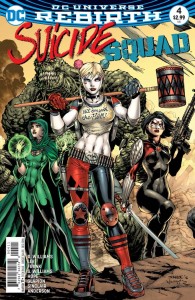 Suicide Squad #4 — Writer: Rob Williams; Pencils: Jim Lee; Inks: Scott Williams, Sandra Hope, Jonathan Glapion and Trevor Scott; Colors: Alex Sinclair and Hi-Fi
Suicide Squad #4 — Writer: Rob Williams; Pencils: Jim Lee; Inks: Scott Williams, Sandra Hope, Jonathan Glapion and Trevor Scott; Colors: Alex Sinclair and Hi-Fi
Deathstroke #4 — Writer: Christopher Priest; Pencils: Joe Bennett; Inks: Mark Morales; Colors: Jeromy Cox
All-Star Batman #3 — Writer: Scott Snyder; Pencils: John Romita Jr.; Inks: Danny Miki; Colors: Dean White
 Detective Comics #942 — Writers: Steve Orlando with James Tynion IV; Art: Andy Macdonald; Colors: John Rauch
Detective Comics #942 — Writers: Steve Orlando with James Tynion IV; Art: Andy Macdonald; Colors: John Rauch
Action Comics #965 — Writer: Dan Jurgens; Pencils: Stephen Segovia; Inks: Art Thibert; Colors: Arif Prianto
Lumberjanes/Gotham Academy #5 (of 6) — Writer: Chynna Clugston-Flores; Pencils: Kelly and Nicole Matthews; Inks: Jenna 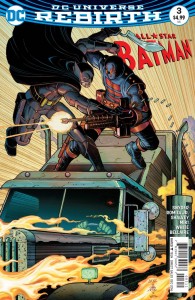 Ayoub; Colors: Whitney Cogar
Ayoub; Colors: Whitney Cogar
All the other DC comics of note — Suicide Squad continues to outperform the movie, with Rob Williams showing a knack for psychopathic banter and psychology, and Jim Lee providing a kickass Harley — and the ’90s version of Amanda Waller: short, stout and the most imposing, dangerous woman in the DC universe. The back-up story has Gary Frank drawing Harley, Rick Flagg and the Joker, so 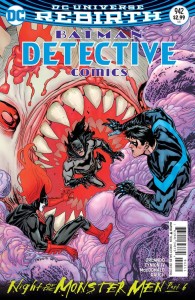 that’s two decent artists, and more than enough reason to buy the comic. Deathstroke has some father/daughter assassin bonding with the Ravager, plus the beginnings of a face-off with Batman; Christopher Priest continues to provide better scripting and plotting than the character’s had in a long time. Speaking of the Caped Crusader, All-Star Batman delves into the Bruce Wayne/Harvey Dent relationship (although, really, the fact that it’s a
that’s two decent artists, and more than enough reason to buy the comic. Deathstroke has some father/daughter assassin bonding with the Ravager, plus the beginnings of a face-off with Batman; Christopher Priest continues to provide better scripting and plotting than the character’s had in a long time. Speaking of the Caped Crusader, All-Star Batman delves into the Bruce Wayne/Harvey Dent relationship (although, really, the fact that it’s a 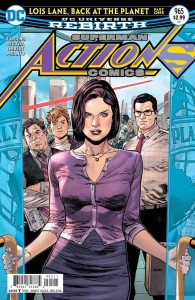 Batman/Two-Face story by Scott Snyder and John Romita Jr. should be all you need to know about it), while Detective concludes the six-part crossover “Night of the Monster Men” with the bat-crew battling a mega-giant monster menacing Gotham — not to mention its creator, Hugo Strange. Meanwhile, Action sees the pre-New 52 Lois Lane — the one married to the new/old Superman — showing up at the Daily Planet and trying to pass as the old/New 52 Lois,
Batman/Two-Face story by Scott Snyder and John Romita Jr. should be all you need to know about it), while Detective concludes the six-part crossover “Night of the Monster Men” with the bat-crew battling a mega-giant monster menacing Gotham — not to mention its creator, Hugo Strange. Meanwhile, Action sees the pre-New 52 Lois Lane — the one married to the new/old Superman — showing up at the Daily Planet and trying to pass as the old/New 52 Lois, 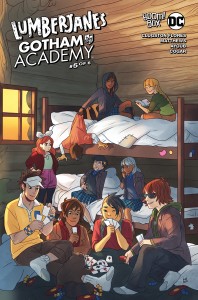 who’s now dead after absorbing some of the also-now-dead New 52 Superman’s powers and then blowing up (man, if you’ve been away from the DC Universe for the last year, you’ve got some catching up to do, eh?). Lumberjanes/Gotham Academy, certainly the coolest inter-company crossover of the year, continues its tale with its large cast of characters trapped in a jilted lover’s timewarp fantasy: creepy cartoony fun, but get the earlier installments first — this penultimate issue isn’t the place to start.
who’s now dead after absorbing some of the also-now-dead New 52 Superman’s powers and then blowing up (man, if you’ve been away from the DC Universe for the last year, you’ve got some catching up to do, eh?). Lumberjanes/Gotham Academy, certainly the coolest inter-company crossover of the year, continues its tale with its large cast of characters trapped in a jilted lover’s timewarp fantasy: creepy cartoony fun, but get the earlier installments first — this penultimate issue isn’t the place to start.
 Reborn #1 — Writer: Mark Millar; Pencils: Greg Capullo; Inks: Jonathan Glapion; Colors: FCO Plascencia
Reborn #1 — Writer: Mark Millar; Pencils: Greg Capullo; Inks: Jonathan Glapion; Colors: FCO Plascencia
Jupiter’s Legacy 2 #4 (of 5) — Writer: Mark Millar; Art: Frank Quitely; Colors: Sunny Gho
Cinema Purgatorio #6 — Creators: Various
Kill or be Killed #3 — Writer: Ed Brubaker; Art: Sean Phillips; Colors: Elizabeth Breitweiser
Monstress #7 — Writer: Marjorie Liu; 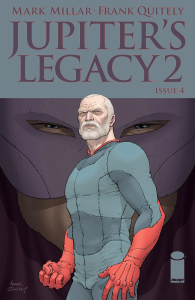 Art/Colors: Sana Takeda
Art/Colors: Sana Takeda
Lazarus #25 — Writer: Greg Rucka; Pencils: Michael Lark; Inks: Michael Lark and Tyler Boss; Colors: Santi Arcas
Chimichanga #1 (of 4) — Writer: Eric Powell; Art/Colors: Stephanie Buscema
The rest of the smaller-press books, including two by Mark Millar: Reborn is an sf epic about how, when we die, we end up on a magic barbarian planet fighting for good… or something; it’s a little hard to tell after just one issue. Greg Capullo, fresh off the last couple of years on Batman, gets in a couple of cool  widescreen magical-barbarian battle shots, with presumably a lot more to come next issue, now that we’re off boring old Earth. Millar’s nothing if not an attractive writer for good artists to collaborate with: Jupiter’s Legacy 2, his other comic this week, offers Frank Quitely’s sleek superhero art in an issue that’s mostly a big, gorgeous-looking fight, as Millar’s tale of an America taken over by a totalitarian Superman avatar and his colleagues, leading to a civil war with the other capes, hits its penultimate issue. Cinema Purgatorio offers more of Alan Moore and Kevin O’Neill’s movies-in-hell series, this one imagining the
widescreen magical-barbarian battle shots, with presumably a lot more to come next issue, now that we’re off boring old Earth. Millar’s nothing if not an attractive writer for good artists to collaborate with: Jupiter’s Legacy 2, his other comic this week, offers Frank Quitely’s sleek superhero art in an issue that’s mostly a big, gorgeous-looking fight, as Millar’s tale of an America taken over by a totalitarian Superman avatar and his colleagues, leading to a civil war with the other capes, hits its penultimate issue. Cinema Purgatorio offers more of Alan Moore and Kevin O’Neill’s movies-in-hell series, this one imagining the 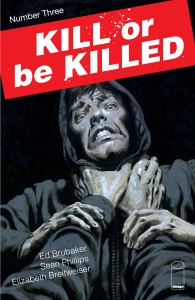 Warner Brothers as the Marx Brothers, with a bunch of dyspeptic movie-insider history of that company thrown in (and a great O’Neill Groucho cover); it’s also got black-and-white serials from Garth Ennis and Raulo Caceres (Code Pru, about an EMT who keeps encountering supernatural archetypes while working the late shift); Max Brooks and Michael DiPascale (A More Perfect Union, an alternate history wherein the North and South cancelled the Civil War to fight an invasion of giant ants); Kieron Gillen and Nahuel Lopez (Modded, about an other-
Warner Brothers as the Marx Brothers, with a bunch of dyspeptic movie-insider history of that company thrown in (and a great O’Neill Groucho cover); it’s also got black-and-white serials from Garth Ennis and Raulo Caceres (Code Pru, about an EMT who keeps encountering supernatural archetypes while working the late shift); Max Brooks and Michael DiPascale (A More Perfect Union, an alternate history wherein the North and South cancelled the Civil War to fight an invasion of giant ants); Kieron Gillen and Nahuel Lopez (Modded, about an other-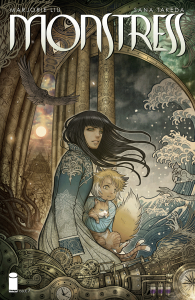 dimensional invasion fought using Pokemon-like demons); and Christos Gage and Gabriel Andrade (The Vast, another giant-monster invasion story). Kill or be Killed continues the latest Ed Brubaker/Sean Phillips crime-suspense book, about a suicide who’s saved by a demon, but with a condition: he has to kill someone, whomever he wants, every month, or he dies instead. The demon may or may not be real — it probably is, but we see very little of it — since the real point is to show how someone like us would go about that
dimensional invasion fought using Pokemon-like demons); and Christos Gage and Gabriel Andrade (The Vast, another giant-monster invasion story). Kill or be Killed continues the latest Ed Brubaker/Sean Phillips crime-suspense book, about a suicide who’s saved by a demon, but with a condition: he has to kill someone, whomever he wants, every month, or he dies instead. The demon may or may not be real — it probably is, but we see very little of it — since the real point is to show how someone like us would go about that 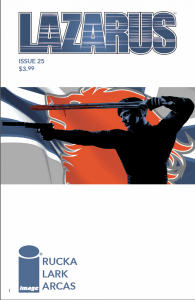 assignment and still keep their soul, by finding only bad guys to murder, and gradually learning how to commit the crime every month and get away with it. Monstress is the return of Liu and Takeda’s very manga-inflluenced hit about a warrior girl in a magical land who has a Lovecreftian-style demon inside of her; the wide sweep of the story, and the sometimes cute/sometimes monstrous art, are the big attractions. Lazarus hits its 25th issue, and if, like me, you liked its tale of a near-future Earth where family corporations rule and fight one another, with the other 99% of the population no
assignment and still keep their soul, by finding only bad guys to murder, and gradually learning how to commit the crime every month and get away with it. Monstress is the return of Liu and Takeda’s very manga-inflluenced hit about a warrior girl in a magical land who has a Lovecreftian-style demon inside of her; the wide sweep of the story, and the sometimes cute/sometimes monstrous art, are the big attractions. Lazarus hits its 25th issue, and if, like me, you liked its tale of a near-future Earth where family corporations rule and fight one another, with the other 99% of the population no 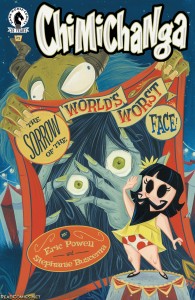 better than peasants, but have neglected it lately, this is a good jumping-back-on point, as the title character, a family enforcer who’s practically immortal, but little more than a slave herself, gets a couple of game-changing revelations that break the book out of its rut and set it on a new path, a rebirth that fits both the book (and character) title nicely. Chimichanga is from the fevered mind of Eric Powell, and involves a little girl who’s a bearded freak in a carnival, and the title monster, who’s both her pet and best friend. Stephanie Buscema’s brightly-colored art walks a tightrope between cute and grotesque, which makes her a perfect complement to Powell’s similarly-balanced story.
better than peasants, but have neglected it lately, this is a good jumping-back-on point, as the title character, a family enforcer who’s practically immortal, but little more than a slave herself, gets a couple of game-changing revelations that break the book out of its rut and set it on a new path, a rebirth that fits both the book (and character) title nicely. Chimichanga is from the fevered mind of Eric Powell, and involves a little girl who’s a bearded freak in a carnival, and the title monster, who’s both her pet and best friend. Stephanie Buscema’s brightly-colored art walks a tightrope between cute and grotesque, which makes her a perfect complement to Powell’s similarly-balanced story.



